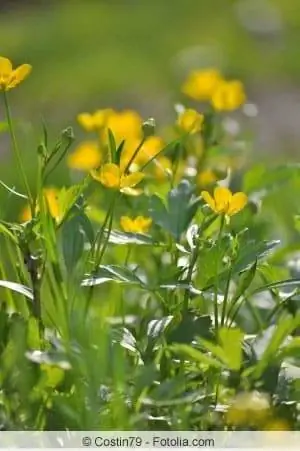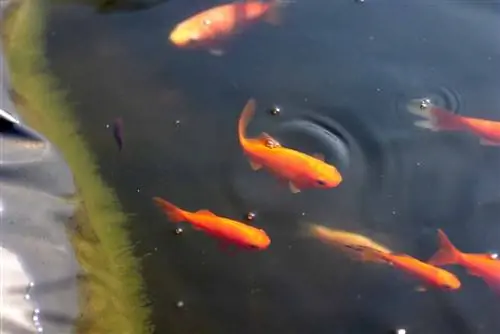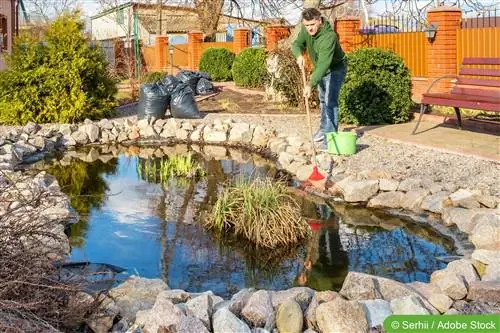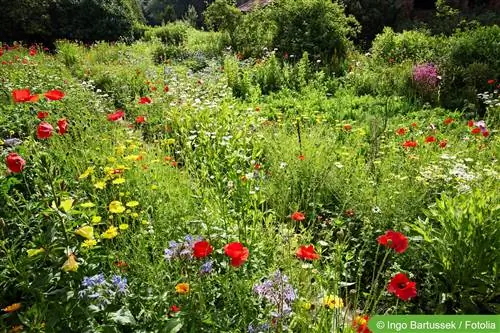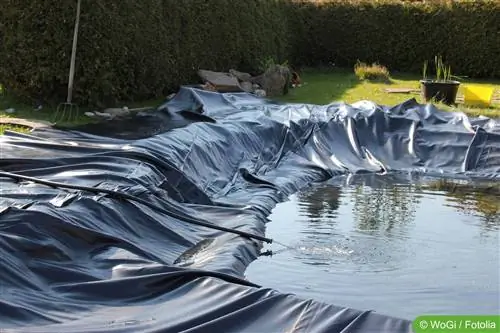- Author admin [email protected].
- Public 2023-12-17 03:39.
- Last modified 2025-01-24 12:45.
You have a “hollow” in the garden, solid clay soil and fill in rainwater. This is basically a natural pond, even if it requires a lot more to create and maintain it.
Important for a natural pond
- Clay soil is ideal as a substrate, even if the pond is never 100 percent tight
- It is essential to use nutrient-poor soil
- No pond soil
- No garden soil
- No plant substrate
- Only use lime-free sand (quartz sand) or gravel
- Rainwater is best
- Under no circumstances fertilizer
- Only place plants in containers with sand, no pond soil
- Only cover the edge of the pond with sand
- Never use filter systems, circulation pumps or fountains, they do not belong in a natural pond
Location and circumstances
A low groundwater table is ideal for a natural pond. Only the pond bottom and the corresponding water terraces need to be formed here. On the other hand, anyone who has a high groundwater table but strong clay soil can easily create a natural pond. A regulated water exchange also takes place here. The groundwater and rain determine the water level in the pond. This is the ideal natural pond. If you don't find either of these naturally, you can help, but with a lot of effort and some costs. The pond bottom can be sealed naturally and in an environmentally friendly way. Apply a 40 to 60 cm thick layer of tamped clay. This doesn't offer 100 percent protection against leaks, but it usually works very well. However, what is important if you want clear water in the pond is to apply an approximately 20 cm thick layer of nutrient-poor sand to the clay.
- Low groundwater level is ideal for natural pond
- Strong clay soil also
- Alternatively, apply a thick layer of tamped clay
The lighting conditions are important for a natural pond. They have to be very balanced. Sun is good, but there should also be shady areas, at least temporarily. Plenty of sun is particularly important in spring so that offspring of insects and amphibians can develop well. On the other hand, floating leaf and floating plants also need partial shade or even shade.
- Sunny, partially shaded and shady areas as possible
- Shadow can also be created artificially, sun cannot
Ideal shape and size of a natural pond
The shape doesn't matter, as long as it's natural. A circular or strictly rectangular or square pond is not natural. A kidney-shaped pond with a bridge over the narrow place looks very beautiful. From there you can also easily observe the creatures in and around the pond. In order to be able to carry out maintenance work and thin out plants, it is an advantage to have an entry point from which you can safely climb into the pond. Different depth zones are also important, one for marsh plants, one for shallow water plants and one for deep water plants. It is important that a shallow water zone is particularly sunny in spring for the expected frogs and their spawn.
- Form unimportant
- Natural shape, not circular or strictly rectangular
- Entry position is an advantage
- Various terraces for plants
- Sunny shallow water area
- Shallow zones for animals that want to get out of the water
The main thing that matters when it comes to size is the depth. A natural pond should be at least 80 cm deep, 100 cm is even better. This ensures that amphibians and insect larvae that overwinter in harsh winters do not freeze to death. Of course the pond can also be deeper. But more than 180 cm is not necessary.
- Size unimportant
- Depth is crucial
- At least 80 cm, better 100
- At least 20 cm wide pond edge, preferably more
Tip:
No matter how big the natural pond is, it must be secured. Either you fence the entire property or the pond specifically. It must be prevented that anyone gets hurt. Children are magically attracted to water and there are always tragic accidents when they fall into it. As a garden owner you are liable for this.
Create a natural pond
Of course, a plan must first be drawn up as to what the pond should look like. You can mark the floor plan with a thick cord or use sand to mark it. Then the pond is dug up. The edge of the pond should be at least 20 cm deep and, depending on the size of the pond, 20 to 100 cm wide. The floor must be the same height all around. The best way to check this is with a hose level.
- Create plan
- Mark pond outlines
- Dig up pond
The excavated soil can be used to design the garden in smaller quantities. In large ponds, however, it is usually too much and has to be removed. Since very few gardens have clay soil, it can be assumed that a layer of clay will have to be added. Since this should be up to 60 cm thick, you have to dig deeper. Of course you have to have the clay delivered to you. It is important to use a protective grid at the bottom of the pond so that mice and other animals cannot undermine the soil under the pond. The water would run out there. This must be prevented before the clay layer is applied. This should be applied in layers. In between, we keep wetting and tamping so that the ground becomes absolutely sealed. The clay must not dry during this entire time, as cracks quickly form and impermeability is not achieved. The layer in the middle of the pond only needs to be about 50 cm thick, but on the flatter sides, where the risk of drying out is quite high, it should be at least 60 cm thick. The thickness must then be reduced to 30 cm up to the edge of the bank. Once the clay layer has been applied, it must dry.
Tip:
Adobe or unfired clay bricks have also been available in stores for some time now. They make sealing a natural pond easier and are easier to transport. A pond fleece is placed here to compensate for any unevenness that may occur when the bricks are compacted. Laying out the wet bricks is strenuous because the dry pieces already weigh 16 kg. The bricks are laid out close together and then compacted with a vibratory vibrator. There should be a fleece on top and then the sand or lime-free gravel. The fleece ensures that the gravel does not press into the clay. Building this version is much more difficult than working with loose clay, or so the experts say.
If the clay has dried well, water can theoretically be let in. It is important to only use rainwater. Of course, this has to be collected beforehand or you can run a rain pipe from the roof into the pond. However, it is a good idea to first lay a layer of sand over the clay. This prevents the plants from coming into direct contact with the nutrient-rich clay. This leads to very strong plant growth. The sand also prevents the water from becoming cloudy. A pure clay pond always has cloudy water. If you don't mind that, you can leave the floor as is. If you would rather see something in the pond, put sand in the pond. A layer about 20 cm thick is ideal. The aquatic plants can also be used right at the beginning to save yourself wet feet.
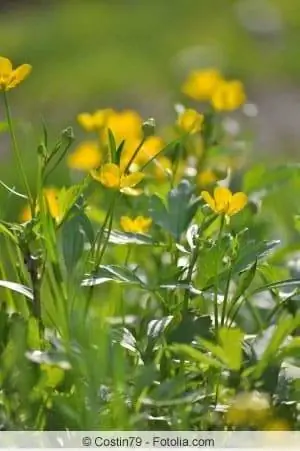
Plant a natural pond
There is not much to consider when planting. The right plants must be selected for the individual zones. Of course, a natural pond does not contain exotic plants, but rather native ones. Actually, nothing needs to be planted. Enough plants establish themselves quite quickly. With these you can be absolutely sure that they are plants that are suitable for the location and that they will get along perfectly. Wild plants do best in a natural pond, so it's better to avoid cultivated forms. Reeds can thrive in water up to one meter deep, but also thrive in shallower waters. You have to be careful that the plants don't spread too much. Cattails have similar requirements, but spread less.
Deep water zone
White Water Lily
Underwater plants
- hornwort
- Waterplague
- Tannwedel
- Pond Mummel (only for larger ponds)
Shallow water zone
- fever clover
- Frog spoon
- Bulrushes
Swamp Zone
Swamp Marigold
In a natural pond, less is more. Many plants spread quickly and rapidly and a large proportion are simply overgrown. It's better not to plant as many plants as wild plants will naturally establish themselves. The plants are placed directly in the sand layer. They root into the clay and then they are solid. This has a disadvantage: it is extremely difficult to get them out again. When reeds and cane plants are torn out, the pond can even become leaky because a lot of clay is removed. Therefore, careful consideration must be given to which plants are used. Alternatively, plant baskets can be used and buried, even if they don't really fit in a natural pond. Do not use soil, place in sand or gravel without substrate.
Conclusion
A natural pond is a great thing, but it doesn't just have advantages. It is important to get the clay very, very firm and free of cracks and to add a thick layer of sand so that you don't end up with a brown pool. Otherwise, clay is a natural building element and the pond offers many creatures a natural habitat, without any chemicals. However, you have to take into account that the construction will take some time and may be expensive and that a pond that is not professionally constructed can also leak. In addition, plant growth is greatly encouraged by the clay soil; the plants tend to proliferate.
It is important that no fish come into the pond. Firstly, no amphibians would have a chance to survive and secondly, the water would become very polluted and the pond would silt up more quickly. A natural pond does not have a filter system. This makes it clear that he does not have eternal life either. The water will become less and less. The larger the pond area, the longer the life expectancy of the pond. A pond of around 10m² silts up after around 5 years, a 50m² pond after around 20 years and a 100m² pond only after around 30 years.

